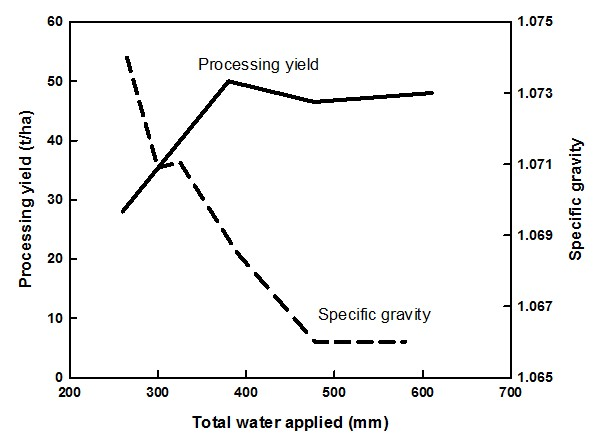Factors affecting specific gravity
Specific gravity will be higher if potato tubers are able to complete their full potential growth cycle without periods of stress. Mature tubers have higher specific gravities than immature tubers. Anything that shortens or interrupts the tuber growth cycle will reduce tuber specific gravity. Varieties also differ in specific gravity.
Varieties
Varieties used for processing normally have higher specific gravity than table potatoes as it is an important characteristic for this use. Nadine, a common fresh market variety, has a low specific gravity and is suitable for mashing and salads but not frying.
Varieties such as Ranger Russet and Bliss have a high specific gravity suitable for French fry and crisp processing respectively, but not for fresh market use.
Discuss choice of variety with the processor, including planting and delivery times and any other agronomic management specific to that variety. Make sure you are aware of the financial incentives offered by the company for delivery of high quality tubers.
Planting time
Specific gravity will be higher in tubers grown during a period of increasing day length and temperature. Crops grown under these conditions usually have more time to mature and produce higher yields.
As specific gravity is related to maturity, the longer a crop grows the more likely it is to produce tubers with high specific gravity. For this reason, crops planted between June and November will produce tubers with higher specific gravity than crops planted in February.
Seed quality and seed-piece size
Planting good, healthy seed will generally give higher yields of high specific gravity potatoes. Use healthy seed to produce vigorous crops that have less disease and have the potential to grow for a longer period.
Cut seed-pieces should weigh between 40g and 60g. Seed-pieces smaller than 40g will usually produce plants of reduced vigour with fewer stems and tubers. Sliver, chip-shaped pieces will reduce planter efficiency and give an uneven stand that produces a lower yield of poorer quality tubers.
Planting density
Low plant density caused by incorrect seed spacing, skips (seed-pieces without ‘eyes’ that don’t germinate) or early decay of the seed-pieces can result in lower specific gravities. Conversely, very high plant densities can lead to early crop maturity and so lower specific gravities, due to excessive competition for nutrients, light and water. Correct plant density is essential for the production of tubers with high specific gravity.
Nutrition
Nitrogen and potassium nutrition can also affect specific gravity. Nitrogen and potassium rates in excess of plant needs may reduce potential yield and tuber specific gravity.
On a potassium responsive site, the use of the potassium sulphate (K2S04) can result in higher specific gravity tubers than when the chloride form is used (KCl, muriate of potash). However, the extra cost of using potassium sulphate will only be recovered if a bonus is paid for higher specific gravity potatoes, or if a small increase in specific gravity is needed to reach the minimum requirement, that is 1.070 or 1.075.
Use soil and tissue analysis to help determine the correct application rates for these nutrients.
Irrigation
Applying water in excess of crop requirements can reduce the final specific gravity (see Figure 2). This is especially so when crops are over-watered near maturity.

Periods of water stress during the growing season will reduce yield and specific gravity. Avoid water stress in loams by maintaining soil moisture levels above 65% of the total available soil moisture until shortly before vine kill or death. The amount of water applied and the frequency of application have a large impact on final yield and tuber quality.
Use scheduling techniques based on evaporation replacement or tensiometers or TDR probe (time domain reflectometry) readings to determine when and how much water to apply to a crop. See Scheduling irrigation of potatoes using tensiometers on South West soils.
Weeds, insects and diseases
Excessive weed growth within a crop can reduce yield and specific gravity through competition for applied nutrients. Use herbicides where necessary to control weeds.
Insect damage to crops can reduce their growth period and so reduce yields and specific gravity.
Specific gravity will also be reduced if plants die off early because of diseases such as early blight (Alternaria solani).
Closely monitor crops and apply fungicides and insecticides when necessary to minimise these pest problems and ensure high yields and high specific gravities.
Soil type
Potatoes produced in sandy soils often have lower specific gravity than those grown on heavier textured soils. However, with proper irrigation and nutrient management, high specific gravity potatoes can be harvested from sandy soils. See Mid West potatoes: irrigation, salinity and harvest management.
Crops on very wet soils can also have low yields and specific gravity. Waterlogged plants will have low growth rates, which results in slower dry matter accumulation and therefore low specific gravity.
Acknowledgement
The original version of this material was authored by Murray Hegney.
